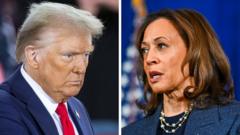Never has a U.S. presidential election been shrouded in such uncertainty as the one looming on the horizon. Historically, while elections have occasionally been nail-biters—like George W. Bush's razor-thin 2000 victory over Al Gore, determined by a mere few hundred Florida votes—there was usually some prevailing narrative in the days leading up to the vote. Yet this cycle presents a complex array of data, with divergent polling indicators that confound predictions.
Current polling figures reflect a dead heat, remaining comfortably within the margin of error across national and seven critical battleground states. This statistical ambiguity leaves political experts, strategists, and candidates alike grappling with the unpredictable nature of voter behavior this election cycle. Surprises in polling—like a recent survey indicating Senator Harris in the lead in traditionally Republican Iowa—have added to the confusion.
Each side has a clear path visualized through key battlegrounds. Harris eyes her "blue wall," which runs through Pennsylvania, Michigan, and Wisconsin—states that were pivotal for both parties in the last two elections. In contrast, Trump is focused on his "red wall" stretching from Pennsylvania down to Georgia, making those states essential for his electoral success.
What amplifies the uncertainty are the potential shifts within key demographic segments. Will Trump truly appeal to a greater proportion of young black and Latino voters as his campaign has suggested? Or might Harris secure significant support from previously Republican-leaning suburban women? The possibility of movements among elderly voters, traditionally Republican, towards the Democratic Party adds another layer to the electoral calculus.
Amid the political maneuvering, this election holds substantial historical significance, as it represents differing ideologies on pressing issues, including immigration, trade, cultural policy, and foreign relations. Consequently, the next President will play a crucial role in shaping the federal landscape and judiciary for years to come.
As the political landscape has notably changed over the past few years, aligning with broader demographic transformations, Tuesday's event may serve as a litmus test for how these evolving trends will redefine U.S. political alignments in the future. While the tight contest may appear to signal a new era of dual-party influence in presidential politics, it cannot be mistaken for stability in any political direction. The results may carry ramifications far beyond the immediate election, recalibrating both parties' strategies for upcoming contests.






















